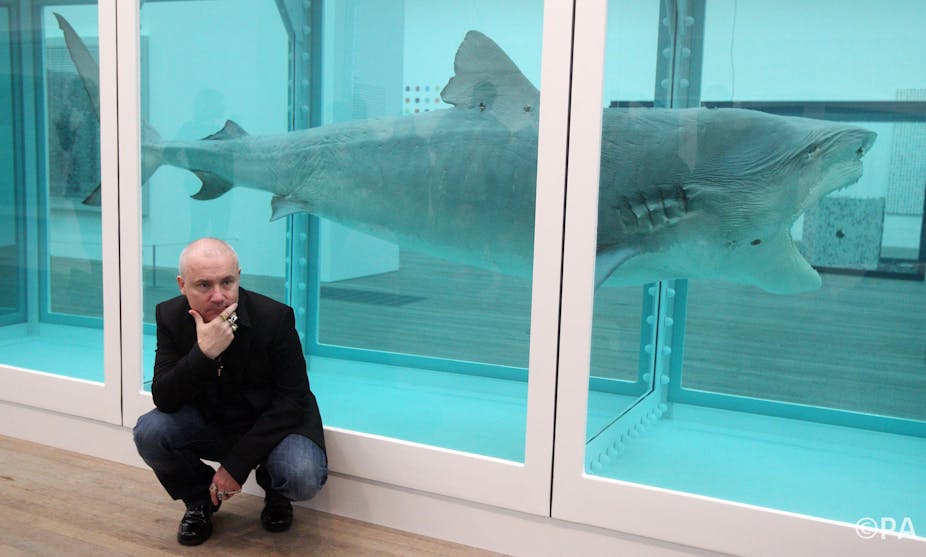Is it right to use the severed head of a newly dead man as a humourous prop for a photograph? And if such a snap exists is it right to display it in art galleries? A photograph of artist Damien Hirst at 16 grinning with his arm around the severed head of a man should make us question the ethics of artistic exhibition.
When my colleague, archaeologist Matt Beamish, went to visit the New Art Gallery, Walsall, he was shocked to see Hirst’s photograph With Dead Head - taken in 1981 but not displayed as art till ten years later - on display with no discussion of the ethical problems it presents.
The head is plainly quite fresh and would be wholly recognisable to anyone who had known him. Knowing that I had written on archaeological ethics and the treatment of the dead before, Matt drew my attention to the exhibit. Together we wrote a letter of complaint to the gallery and later - when we received no response - to a couple of newspapers.
Our objection to the photo is that Hirst has betrayed the dignity of the man whose head is in the photograph. The man had given his body for scientific research. To take and especially to display such a photo is an abuse of power.
Guardian journalist misses the point
Guardian journalist Jonathan Jones has written an article attacking our position, our credentials and, rather snidely, the capacity of archaeologists to voice an opinion at all on matters outside their own narrow trenches.
He argued that the photograph is a provocative work which causes us to think about death which Hirst, he says, has done “more seriously … than any professor of archaeological ethics ever has”. I can’t say how seriously Hirst has thought about death, but I have researched the subject for more than 25 years so I hope I’ve earned my soapbox.
We are not the pompous wielders of the censor’s knife that Jones portrays. At issue here is not whether we are trying to “ban” art, or even what the piece makes us think about. My views on Hirst or on death are not relevant to the point we have made.
What Jones is missing is that there is a third party here: the human being whose image is used, without consent, in an undignified way. This is potentially horrific if there are surviving relatives or friends of the man in the photo. But even if there aren’t it is still an abuse of power.
I can accept that Hirst might say this photo challenges the viewer to rethink their attitudes towards death and the body, and tries to demystify the body by presenting it as a funny object rather than a sacred relic. But there are other ways to make this point, and Hirst’s artistic intention is not a license to abuse the trust, or the body, of another person.

Archaeologists often deal with human remains. A great deal of our knowledge about the past comes from the grave. But we generally do not dig up graves unless we can show a strong research incentive, or the cemetery is threatened with destruction. During excavation and study any human remains we recover are treated seriously and respectfully.
The bones of those who have died in the past 800 years or so are reburied after study, and not publicly displayed. Older remains are sometimes displayed, although this is a subject of controversy among archaeologists. I think it unlikely, however, that any archaeologist would happily display the soft tissue remains of a recognisable individual.
To me the difference between what my archaeological colleagues do and what Hirst has done is in the indignity Hirst inflicts on the subject of his picture. The lack of any purpose beyond display gives us nothing to weigh against that indignity. And the use of a recognisable individual is very different from the dry bones we study.
The right to speak
I reject entirely Jones’s bizarre and ill-informed contention that “Archaeology is the scientific study of the past, and it has no business pronouncing on the ethics of modern art.” Archaeologists have thought about the ethical treatment of human bodies more than most.
And I firmly believe that our subject knowledge gives us an ethical duty to speak for the dead who do not have a voice, and not to step down because an art critic (who presumably feels his own pronouncements are legitimate) seeks to deny us a voice. This is not academic arrogance: it is part of an academic’s job to raise questions and put forward different views.
It is intellectually lazy to respond to criticism with a reflex accusation that the Philistines are trying to suppress art. There is a real and serious criticism here, and judging by the comments responding to Jones’ piece, we are not the only ones to think so. No field of endeavour should be immune from ethical comment. While I regret that our letter had the unfortunate side-effect of generating lots of extra publicity for Hirst, at least we are seeing some public discussion of the ethical limits of art.

